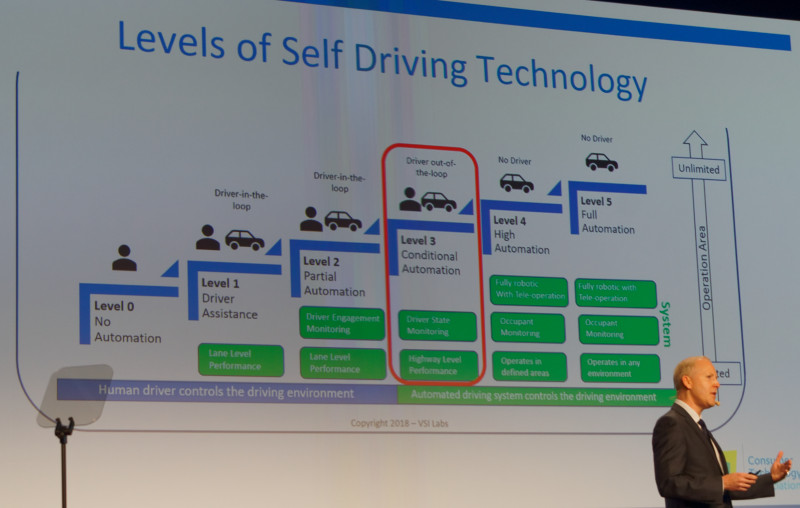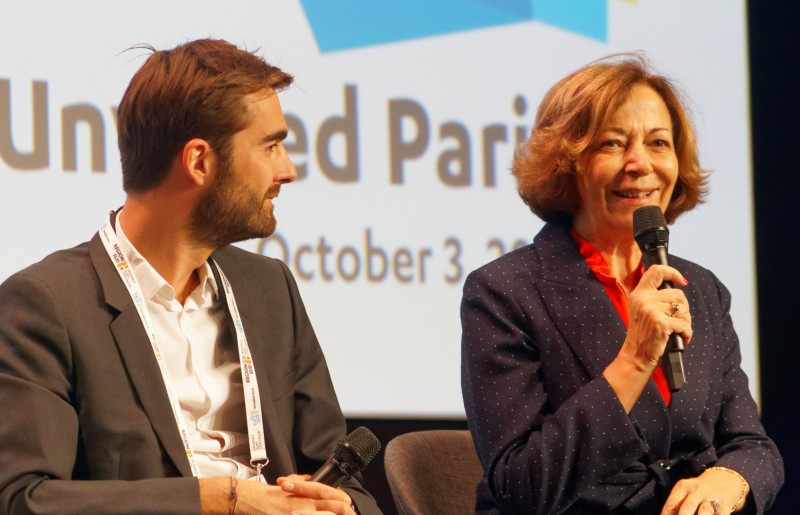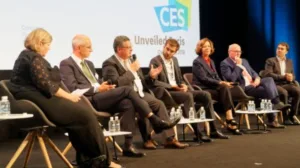Karen Chupka of the CTA moderated an interesting panel session on mobility and focusing largely on autonomous cars. Although there was relatively little on displays, we thought the session was worth reporting.
The panel was
Christophe Périllat is COO of Valeo which is working on many areas of autonmous technology including sensors.
Pierre-Olivier Desmeurs is from Accenture which is working with a range of makers and operators as well as working with technology companies. It collaborates with labs and other organisations
Clément Eulry is Director of Automotive and Mobility at Google which is working to use technology for navigation and mobility. Building platforms such as connecting smart devices to cars using Android
Ann-Marie Idrac is a former minister and senior head for the national strategy for the development of autonomous vehicles.
Patrick Koller is CEO from Faurecia a top tier component supplier which is developing low emission power trains and ‘a smart life on board’ which is how he described the new fuctions you might need when you are not driving so much.
Frédéric Mazzella is from Bla-bla car and the company has a platform to allow possible passengers to find drivers heading the same way to share. 96% of the time, cars are parked. Of the 4%, 0.5% is spent in traffic jams and 0.7% is spent looking for parking. Three quarters of the time cars have only one person – that’s really crazy, Mazzella said. The cost of having a car is 5,000 to 6,000 euros per year in parking/fuel/repairs/depreciation etc That means for France, it is €200 billion per year which is 10% of GDP, but only used 4% of the time. Very economically inefficient. BlaBla Car is in 22 countries and expanding.
 From left to right, Chupka (CTA), Périllat, Desmeurs, Eulry, Idrac, Koller and Mazzella. Image:Meko
From left to right, Chupka (CTA), Périllat, Desmeurs, Eulry, Idrac, Koller and Mazzella. Image:Meko
“What are the biggest changes that are needed to enable autonomy?” was the first question
Idrac said that the key issue is safety, safety, safety both on the road from injury and also data safety including the privacy of data. Regulation and approvals are also big issues and there is much discussion with other regions, especially Japan. What is the acceptability by the population – what are the use cases and how do you make it available at different costs? These are questions still to be answered.
Idfrac went on to say that safety has many challenges – drivers have huge amounts of data presented to them to decide how to drive. Weather, road works? How do you deal with rural areas? You have to decide the level of automation that is appropriate for different use cases. Dealing with all weather conditions is very tricky and many well-populated regions see regular extreme weather. Governments are looking at how to give technical approvals, because of the combination of services, use cases and technology. Governments also have to coordinate their actions as nobody wants to develop different cars or software for different regions.
Périllat pointed out that cars are already very dangerous – there are more than 1 million deaths per year, so safety is a big point. Cost is also a factor – better mobility means more growth in the economy and improvements in the quality of life, so reducing the cost is a big point. The first priority has to be to reduce accidents and loss of life. The industry has been asking regulators not to stop the progress of technology. The Vienna Convention has been changed to allow the testing of self-driving cars, he said. Valeo has one self driving car in Paris. The car has been driven around the Paris Périphérique (which was brave! – Man. Ed) and across Europe. Currently the company has a car driving across Japan. Developments have not blocked by regulators so testing is going well.
Chupka asked about data in navigation and whether there were privacy issues. Eulry from Google said that mobility is costly, stressful and takes a lot of time – a third of people in Europe are stressed every day by the challenges of commuting. There are many more options from smartphones and other technology. Google has seen by looking at searches that there are an increasing number of questions about how to get from one place to another, that is to say people are looking at the means and not just the route. Data is at the heart of making the decision about what kind of transport to use.
 These are five levels of autonomous driving. Image:Meko
These are five levels of autonomous driving. Image:Meko
Koller from Faurecia said that the move to level 5 will happen step by step. We will see robotaxis within months. They won’t be only autonomous and will probably will have remote control options to allow dealing with road works and blockages. Low speed driver aids are driving. Level 5 cars will cost a lot of money, Koller said, and may simply not be affordable for the mass of people. There could be a mix of low cost manual cars, for example with electric drive and for cities, combined with premium cars with autonomy that are shared using ride-sharing services.
Chupka said that private cars are only one solution, there are other transport options.
Desmeurs explained that private cars may just become another kind of public transport – with electric and other cars giving a wide variety of options. 2-3% of the cost of goods is transport and that is expected to double by 2040. He believes that transport and mobility needs managing in mobility networks (not necessarily with people and goods in the same places). Separate networks for delivering goods may be developed.
Idrac said we need a range of options. In a city like Paris you need mass public transport, but you need very different systems at night or in low density areas. The change in thinking is moving from simply a transport question to discussion of mobility solutions and that is a good move, in her view.
Data Partnerships Help
Chupka said that the level of data-based knowledge is different – are there partnerships between different players? Google has data swap arrangements with local authorities. Local governments send details of road blockages and road change plans while Google sends information from Waze about traffic flows which helps traffic management.
Mazzella from BlaBla car said that his company has a lot information about where people are going for holidays and weekends. That data can be used to predict traffic flows from the requests, but it is difficult to forecast in the longer term because if people see potential problems in the future and they might modify their behaviour.
Périllat said technical challenges are many. For safety you need redundancy so that if one system fails, another works to avoid problems. It is also hard to deal with the level of complexity in driving. Just describing situations is very difficult and its very hard to test for even the described situations, but there are always new or different scenarios. The number of requirements from regulators and specifiers can run into thousands and tens of thousands. AI becomes critical in learning situations that are not in the established use cases. Accenture has more than 100 engineers in Paris working on deep learning for autonomous cars.
Koller added that challenges also depend on consumers. Consumers will decide what scenario actually plays out. From his point of view, up to now, auto makers have made the cars that they want to and then persuaded people to buy them. That is changing now – for example, he said if the Waze app doesn’t work, consumers simply don’t buy the car. People want to win time and the time in the car has to become productive. Makers will need to understand the ‘hassle map’ of consumers. The use case of the consumer may change during the life cycle of the car and that is also a challenge. Further, cars may need upgrading in the future as fixed cars will not be acceptable to the buyer. There is a shift in value creation between industry and services – the industry doesn’t really understand where the value will be in the future. At the moment the activities of service providers is seen as competition, but collaboration to find the value add may be a better way for long term success.
He also pointed out that for three people in the car, the vehicle is already autonomous. “What happens if you have a baby – should you be able to change the interior?”, he asked. The car industry is a B2C industry but it is maybe the only one that is a ‘heavy industry’.
Chupka asked about the potential change in car ownership. BlaBla obviously has an unusual view. Mazzella pointed out that in the Bladerunner film (which is set in 2019), there are clones and flying cars but Harrison Ford has no smartphone – he uses a coin-based public phone. BlaBla believes that sharing will be the rule. Owning cars is not a good model for the future. However, some companies will own large fleets. but will it be the car makers, the service companies (Google/ Uber/ BlaBla) or rental companies?
Idrac said the economic argument is a strong one – and she added that the specificity of each kind of supplier is not so clear these days – the edges are blurring. Car makers are offering a variety of business models Who will pay for the ownership of cars in the future? Idrac has not yet people that are ready to put up the capex for this. There have been some experiences in France but at the moment the car maker or the govt is paying for car sharing. Banks and insurance companies are likely to be very important in providing money to purchase shared car fleets.
 Idrac said that so far she hasn’t met anybody that wants to put up a lot of money for car sharing fleets. Image:Meko
Idrac said that so far she hasn’t met anybody that wants to put up a lot of money for car sharing fleets. Image:Meko
Koller agreed with complexity of forecast. He pointed out that on Friday evenings there is more traffic – more mobility is needed to deal with peaks. You have to finance the peak and someone has to pay. Mobility will be guaranteed – then would you really want to buy a car? Availablity and affordability are critical, in his view. In the past you could lend other people your Nokia phone, but now, he said, you dont give away your smartphone because of the level of data on it. If a big part of your life is in it you might not want to share and cars could store a lot of data.
Périllat explained that the cost of mobility has been stable for around twenty years, but technology is ready to disrupt this and in the future the cost will decrease because that is what is wanted by consumer. Will the number of trips go down or will the numbers go up as cost goes down? It depends on what you believe, he said. Also, where the value goes is undecided.
Idrac pointed out that congestion becomes a big problem if the number of cars grows as it could if mobility is cheaper and more convenient. If policies are not well developed the effect could be bad.
Desmeurs said we are thinking only about cars – but there should be a seamless system but nobody yet knows what is the optimum combination of products? Bus, train, flight, car? What will it cost? You must think of the big picture, including cost. Mobility is not a new concept. Cultures and regulations will change how things work out globally.
There was some discussion about public transport. A monthly season ticket for travel in Paris has a €70 price – but the cost is €200 per person. BlaBla asked, if you subsidise some forms of shared transport, how do you bring public money into the internet systems. There is a big tax load on the car and that money is distributed to transport systems.
Desmurs said that in his experience, all public transport is subsidised in some way and Paris prices are very heavily subsidised. The cost is the same wherever you are, but the price and the experience may be different in different regions of the world.
In answering a question about timings, Koller said that he really thinks it will be 2040 before there are significant numbers of private cars with level 5 autonomous capability.

